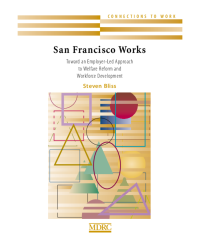San Francisco Works
Toward an Employer-Led Approach to Welfare Reform and Workforce Development
San Francisco Works (SFWorks)—a collaboration among the Committee on Jobs (a coalition of San Francisco’s 35 largest businesses), the San Francisco Chamber of Commerce, and the United Way of the Bay Area—was established in 1997 to coordinate the San Francisco business community’s involvement in local welfare-to-work efforts. SFWorks initially set out to achieve two key objectives: (1) creating job training programs closely tied to real workforce needs, and with the participation of actual employers; and (2) helping welfare recipients obtain jobs with wages high enough to make entry-level work more financially attractive than welfare. SFWorks also planned to use performance-based payments (for job training services) as a way of motivating community-based organizations to run more efficient training programs.
Initial funding for SFWorks came primarily from the business community and private foundations. Several of San Francisco’s largest businesses—including Bank of America, Charles Schwab & Co., The Gap, Pacific Telesis, and Wells Fargo Bank—made three-year commitments for as much as $250,000, while The Rockefeller Foundation, the James Irvine Foundation, the William and Flora Hewlett Foundation, the F.B. Heron Foundation, and the Cahill Foundation all provided major start-up funds. In light of this substantial level of support, SFWorks initially planned to avoid any reliance on public funds. This changed, however, when SFWorks decided to seek funds through the state Employment Training Panel (ETP) as a way of boosting the program’s ability to pay wages to participants during training. SFWorks’ initial contract with ETP totaled more than $3 million. (As it turned out, SFWorks would ultimately receive only a small fraction of this amount, largely because of the general incompatibility between SFWorks’ program design and the strict stipulations attached to ETP funds.)
SFWorks’ job training efforts merit attention because they illustrate broader lessons and themes concerning workforce development and business sector-led welfare-to-work programs.






